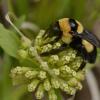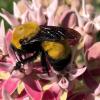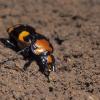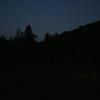
(Arthropoda: Insecta: Hemiptera: Heteroptera: Pentatomoidea: Scutelleridae)
This rare, tall grass prairie specialist inhabits high elevation (e.g., 900 m) natural balds and meadows in California and Oregon. Known from very few sites, further documentation of its range and habitat is critical for advancing our understanding of its needs and taking the appropriate conservation measures.
Scutellerids are distinguished from other hemipterans by the greatly enlarged scutellum that covers the entire abdomen like a shield, hence the common name “shield-backed bugs.” The similar pentatomid bugs are distinguished from scutellerids by having a smaller scutellum that does not cover the wings and abdomen. Juvenile stages of scutellerids look similar to adults, but are smaller, have less-developed wings and scutella, and may be difficult to identify to species. Identification is therefore best conducted using adult specimens, recognizable by the fully-enlarged scutella and fully-developed wings. Field identification is possible by those familiar with heteropteran taxonomy, and can be accomplished by non-experts who have examined and become familiar with museum specimens. Field identification may be facilitated using photographs of the species and of common look-alike species. Confirmation of field identifications should be done by taxonomic experts with experience identifying scutellerids.
This subspecies can be readily distinguished from the similar V. b. borealis by the narrower head, truncate apically; acute (not rounded) antero-lateral angle of the pronotum; general gray-brown color with trace of fuscous maculations on scutellum; scutellum with apical pale spot; connexivum more distinctly alternated; and slightly differing female genital plates and male aedeagus (Lattin 1964). The specimens of this subspecies are remarkably similar in appearance throughout its range (Lattin 1964).
The technical description for this subspecies is as follows (Lattin 1964):
Male: length 6.3 mm, width 3.7 mm. Head: length 1.6 mm, width including eyes 2.08 mm. Pronotum: length 1.6 mm, width 3.58 mm. Scutellum: length 3.52 mm, width 3.44 mm. Proportions of antennal segments I to V: 2.5:2.0:2.0:3.4:5.3; proportions of rostral segments I to IV: 3.5:7.5:3.0:2.5. The male aedeagus is very similar to that of V. b. borealis except for the shape of the sclerotized portions of the biramous apical conjunctival appendages.
Female: length 7.5 mm., width 4.3 mm. Eighth terga strongly concave, spiracles small, dorsal margin of ninth terga slightly angulate, first gonocoxites not impressed medially.
The holotype (male) and allotype (female) are deposited at the California Academy of Sciences, San Francisco, California (#1748 and #1749) (Lattin 1964). Additionally, there are four specimens in John Lattin’s research collection at Oregon State University, and one specimen is reported to be housed in the Arthropod Collection at Oregon State University, although this specimen was not recovered during a recent (2009) visit.
The life history of this subspecies is poorly known, but it is probably best surveyed for in mid-summer (Lattin 2009, pers. comm.). It is known in Oregon from just two collections; the specimen from Hood River County was collected on July 5th, 1927, while the collection date for the Lane County record is unknown. In California, this subspecies has been collected from June 4th through August 10th, 1911 to 1951.
The subspecies Vanduzeeina borealis californica is known only from California (Yosemite National Park and Cisco, just west of Donner Pass) and Oregon (Mt. Hood area, Hood River County and H. J. Andrews Experimental Forest, eastern Lane County).
Forest Service/BLM Land: This subspecies has been documented on the Willamette National Forest and either on or near (<1.6 km away from) Mt. Hood National Forest. It is suspected in the Umpqua, Siuslaw, and Rogue River-Siskiyou National Forests, and on BLM land in the Eugene, Salem, Roseburg, Medford, Lakeview, and Coos Bay Districts (Lattin 2009, pers. comm.). In the Eugene District, it may inhabit BLM land in the McKenzie Resource Area (Applegarth 1995).
The range of this species extends from the Sierra Nevada of California, east to Illinois and South Dakota, and north through the forested mountain ranges to the Yukon Territory of Canada (Applegarth 1995, McPherson 1982). In Canada, V. borealis has been recorded in the Yukon, British Columbia, Alberta, Manitoba and Ontario (Maw et al. 2000, Strickland 1953).
A tall grass prairie specialist, this subspecies inhabits high elevation (e.g. 900 m) natural balds and meadows (Applegarth 1995).
Global Status (2001): G3T3
Rounded Global Status: T3 – Vulnerable
National Status (United States): NNR
State Status: Oregon (S1), California (not evaluated)
(NatureServe 2008).
Since the distribution of this subspecies is not well known, establishment of regionally specific threats is difficult. Habitat disturbance and degradation via cattle-grazing, agriculture, exotic grasses, road construction, building construction, and timber harvest may threaten this species.
Inventory: Because this subspecies is known from only two sites in Oregon, further documentation of its range and habitat is critical for advancing our understanding of its needs and taking the appropriate conservation measures. At a minimum, revisit appropriate habitat (high elevation natural balds and meadows) at the Mt. Hood site and in the H. J. Andrews Experimental Forest, in an effort to establish the current status of the subspecies at these sites. Explore similar habitat in unsurveyed territory in the Oregon Cascades, Coast Range, and Siskiyou Mountains, and survey for this species. Since population size is important in evaluating the stability of a species at a given locality, abundance estimates for this species would also be valuable.
Management: Protect all new and known sites from practices that would adversely affect any aspect of this species’ life cycle, including exotic grasses, cattle-grazing, agriculture, road construction, building construction, and timber harvest.
Applegarth, J.S. 1995. Invertebrates of special status or special concern in the Eugene district. U.S. Department of the Interior, Bureau of Land Management.
Lattin, J.D. 1964. The Scutellerinae of America North of Mexico (Hemiptera: Heteroptera: Pentatomidae). Ph.D. Dissertation, Zoology. University of California, Berkeley. University Microfilms, Inc. Ann Arbor, Michigan.
Lattin, John D. 2009. Personal communication with Sarah Foltz.
Maw, H.E.L., Footit, R.G., Hamilton, K.G.A. and Scudder, G.G.E. 2000. Checklist of the Hemiptera of Canada and Alaska, 220 pp.
McPherson, J.E. 1982. The Pentatomoidea (Hemiptera) of northeastern North America with emphasis on the fauna of Illinois. Southern Illinois University Press, Carbondale, IL, 240 pp.
NatureServe. 2008. “Vanduzeeina borealis californica.” NatureServe Explorer: An online encyclopedia of life [web application]. Feb. 2008. Version 7.0. NatureServe, Arlington, Virginia. 15 Dec. 2008 .
Strickland, E.H. 1953. An annotated list of the Hemiptera (s.l.) of Alberta. The Canadian Entomologist 85:193-214.
Triplehorn, C. and N. Johnson. 2005. Introduction to the Study of Insects. Thomson Brooks/Cole, Belmont, CA, 864pp.
Profile prepared by Sarah Foltz Jordan, The Xerces Society for Invertebrate Conservation





